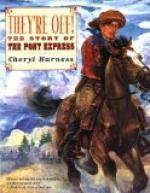The following is a partial list, so far as is known[33], of the men who rode the Pony Express and contributed to the lasting fame of the enterprise:
Baughn, Melville
Beatley, Jim
“Boston”
Boulton, William
Brink, James W.
Burnett, John
Bucklin, Jimmy
Carr, William
Carrigan, William
Cates, Bill
Clark, Jimmy
Cliff, Charles
Cody, William F.
Egan, Major
Ellis, J. K.
Faust, H. J.
Fisher, John
Frey, Johnnie
Gentry, Jim
Gilson, Jim
Hamilton, Sam
Haslam, Robert
Hogan (first name missing)
Huntington, Let
“Irish Tom”
James, William
Jenkins, Will D.
Kelley, Jay G.
Keetley, Jack
“Little Yank”
Martin, Bob
McCall, J. G.
McDonald, James
McNaughton, Jim
Moore, Jim
Perkins, Josh
Rand, Theodore
Richardson, Johnson
Riles, Bart
Rising, Don C.
Roff, Harry
Spurr, George
Thacher, George
Towne, George
Wallace, Henry
Westcott, Dan
Zowgaltz, Jose.
Many of these men were rough and unlettered. Many died deaths of violence. The bones of many lie in unknown graves. Some doubtless lie unburied somewhere in the great West, in the winning of which their lives were lost. Yet be it always remembered, that in the history of the American nation they played an important part. They were bold-hearted citizen knights to whom is due the honors of uncrowned kings.
[29] Afterwards named Fort Churchill. This ride took place in the summer of 1860.
[30] Some reports say that Richardson was stricken with fear. That he was probably suffering from overwrought nerves, resulting from excessive risks which his run had involved, is a more correct inference. This is the only case on record of a pony messenger failing to respond to duty, unless killed or disabled.
[31] After the California Pony Express was abandoned, Bob rode for Wells Fargo & Co., between Friday’s Station and Virginia City, Nevada, a distance of one hundred miles. He seems to have enjoyed horseback riding, for he made this roundtrip journey in twenty-four hours. When the Central Pacific R. R. was built, and this pony line abandoned, Haslam rode for six months a twenty-three mile division between Virginia City and Reno, traveling the distance in less than one hour. To accomplish this feat, he used a relay of fifteen horses. He was afterwards transfered to Idaho where he continued in a similar capacity on a one hundred mile run before quitting the service for a less exciting vocation.




